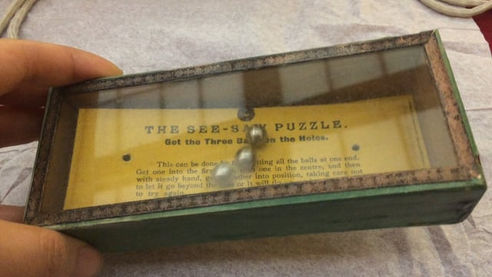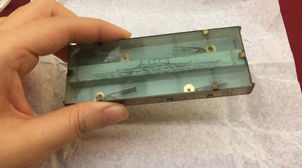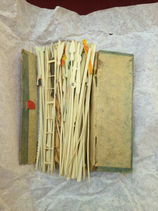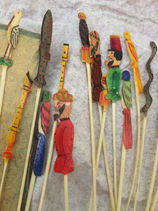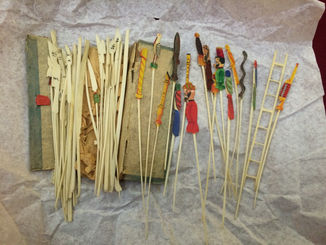
The Politics of Puzzles
All puzzles are held in the Special Collections of The New York Public Library.

The Politics of Puzzles
& the Cipher of Representation
Who in the world are we? And what can puzzles tell us about our past?
Tactile and playful, puzzles are often relegated to school rooms or left firmly in the care of avid puzzlers. But as realia, puzzles serve as physical evidence of bygone eras and the lingering cultural ideas that once prevailed.
Blackanwite Puzzle
1830s-1950s
Dexterity puzzle (metal, paper, unknown materials)
The Blackanwite Puzzle declares, “Get the black balls on one side and the white on the other,” inviting players to separate tiny colored balls. This double-sided puzzle mirrors racist ideas and segregationist policies enforced by the Jim Crow laws between 1877 and 1950. In 1883 the Supreme Court overturned portions of the Civil Rights Act of 1875, opening the way for states to pass laws requiring separation of black and white passengers in public facilities and transportation.


Get Off the Earth Puzzle
ca. 1896
Sam Loyd, New York
Vanishment puzzle (paper, metal)
The Get Off the Earth Puzzle is a famous vanishment puzzle that echoes the anti-Chinese sentiment that swept through the U.S. in the late 1800s. California’s 1849 Gold Rush led to a flood of Chinese laborers that were seen as deceitful and undesirable. This anti-Chinese sentiment reached its peak in the 1870s leading to rallying cries of “The Chinese must go!” and The Chinese Exclusion Act of 1885. Spin the paper disc and make a “Chinaman” vanish!
League of Nations Puzzle
1920s-1930s
Dexterity puzzle (paper, metal, unknown materials)
The League of Nations Puzzle coyly asks, “Can the United States Keep Out of the League?” and tasks the player with arranging “dark balls” along the fence and the “bright ball” in the middle. The completed puzzle provides a symbolic representation of the anti-League of Nations sentiment in the U.S. after WWI and during the Great Depression. Some favored isolationism and U.S. sovereignty while others balked at joining an organization with Asian and African countries. The U.S. ultimately did not join the League of Nations, but later joined the United Nations in 1944.


Amus 'n' Ande Puzzle
1920s-1930s
Busy Bee Sales Co., Boston, MA
Checkerboard puzzle (paper)
[1st checkerboard puzzle by Henry Luers, 1880]
The Amus ‘n’ Ande Puzzle challenges players to assemble a checkerboard and boasts over 80 solutions. Amos ‘n’ Andy was a popular 1930s radio show created by Freeman Gosden and Charles Correll, two white minstrel actors also known for their blackface portrayals in the 1930 film Check and Double Check. Amos ‘n’ Andy resonated with listeners during the Great Depression, but played upon stereotypes of racial inferiority and became synonymous with minstrelsy and blackface.
"Who in the world am I? Ah, that's the great puzzle!"
Lewis Carroll,

Curatorial Reflection
Decrypting the Puzzle
Engaging with these exhibition items was a delight. Opening a box and encountering neat rows of tissue-wrapped puzzles was like encountering a mystery waiting to be solved. Each new item I unwrapped became a small clue that informed my understanding of those preceding it, another piece of the larger puzzle of human history and identity. The puzzles invited play and exploration, and discovering the solutions was a path but not a goal.
I considered many methods of framing and organizing this exhibition. There were several different puzzle types, including jigsaws, jackstraws, tiddledy winks, palm puzzles, and dissection puzzles. I considered an exhibition set in a logical, hierarchical fashion based on time, region, or creator, but abandoned this for a simpler theme. Ultimately, I selected the objects that inspired the most joy. These objects attracted me through their design, tactility, texture, color, sound, or subject matter. My selections were instinctual rather than intellectual, and I drew my exhibition theme around perceived commonalities.
Although my research took place primarily in the Brooke Russell Astor Reading Room, I also viewed three jigsaw puzzles in the Lionel Pincus and Princess Firyal Map Division. I chose The New York Public Library’s Special Collections because of their general accessibility and weekend hours. However, I was unprepared for just how accessible the Map Division was and the conflicts it caused. Unlike the Rare Books Division, which is located past guards and locked doors despite its open-access policy, there is very little gatekeeping for the Map Division. As a result, this public-private space introduced some new challenges. There is only one dedicated table for researchers in the Map Division and the lack of resources made some researchers possessive of the limited space. I also encountered the odd experience of having other visitors circling and digging through the jigsaw puzzles I was examining. But perhaps that only speaks to the irresistible nature of puzzles!

Peruse More Puzzles

Contact
Questions or comments? Please fill out the form below and I will get back to you as soon as possible.



